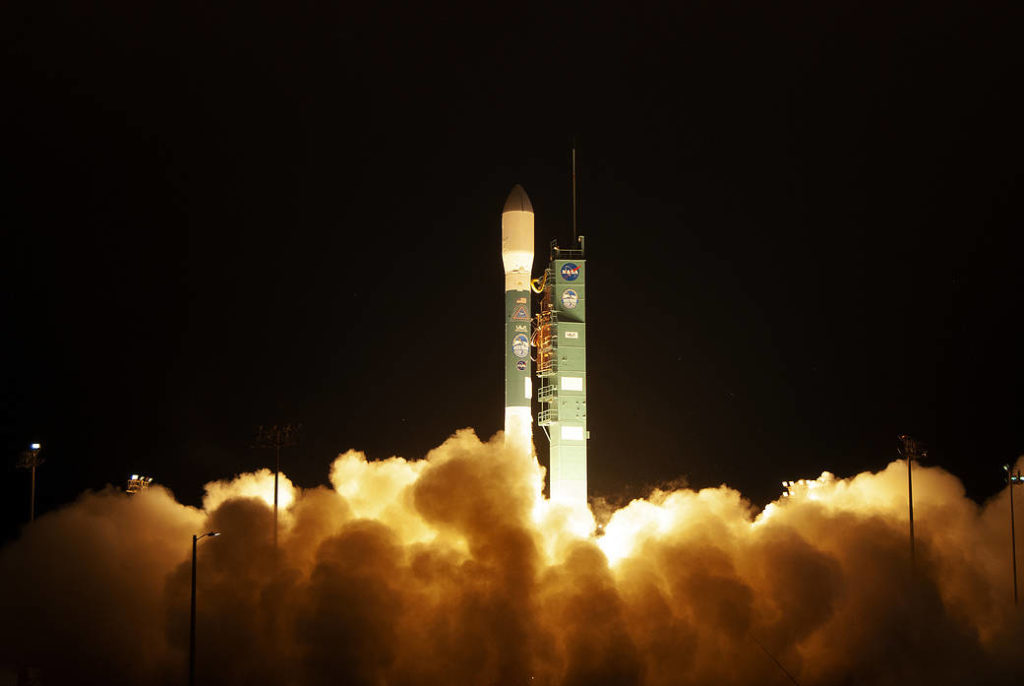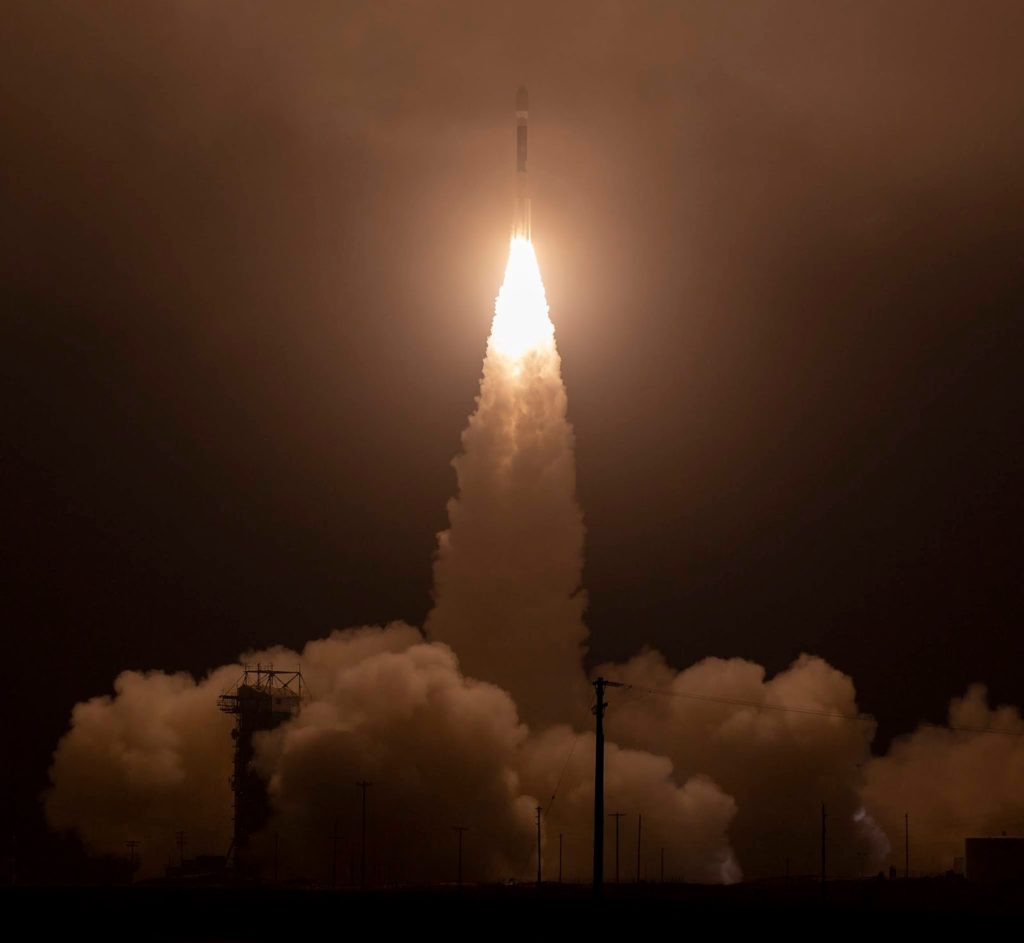— SpaceUpClose.com — 15 September 2018
FL – History’s last Delta II rocket that will ever fly, and that traces
its storied history back to the dawn of the Space Age, successfully launched NASA’s
ICESat-2 spacecraft this morning from Vandenberg
Air Force Base in California on a critical science mission that will probe Earth’s
ever changing ice sheets and contribute unprecedented knowledge to climatic understanding
and changes on our Home Planet.
Launch Alliance (ULA) Delta II’s 155th and final launch at 9:02 a.m. EDT Saturday, September 15, 2018 – after a slight
delay to ensure that pressures in the fuel tanks were within specification.
It
was the end of an era for the two stage 128-foot-tall
(39-meter) Delta II rocket that first launched in 1989 as an upgrade to the original
Delta.
And the rocket put on a spectacular show for all who
watched.
The first stage ignited with approximately 650,000
pounds of thrust spewing from the Aerojet Rocketdyne RS-27A main
engine and four Northrop Grumman-built GEM-40 strap-on solid rocket motors. The solids generated approximately 460,000
pounds of thrust.
 |
|
NASA’s ICESat-2 Launches aboard United Launch
Alliance Delta II Rocket on Sept. 15, 2018, at Vandenberg Air Force Base in California. Credit: NASA |
It was a bittersweet moment for everyone directly involved
in the mission as well as for space enthusiast worldwide who celebrate the many
science and societal accomplishments of the noble rocket – which launched more
than 50 science missions for NASA alone.
exploration of the remote polar regions of our planet and advance our
understanding of how ongoing changes of Earth’s ice cover at the poles and
elsewhere will affect lives around the world, now and in the future,” said
Thomas Zurbuchen, associate administrator of NASA’s Science Mission Directorate,
in a statement.
 |
|
NASA’s ICESat-2 Launches aboard United Launch
Alliance Delta II Rocket on Sept. 15, 2018, at Vandenberg Air Force Base in California. Credit: NASA |
“From
its origin as the launch vehicle for the first Global Positioning System (GPS)
satellites to NASA’s Earth observing, science and interplanetary satellites –
including Mars rovers Spirit and Opportunity – to vital commercial
communication and imaging satellites, the Delta II rocket has truly earned its
place in space history,” said ULA.
“ULA is proud that the Delta II rocket has been a significant piece of history,
launching more than 50 missions for NASA,” said Gary Wentz, ULA vice president
of Government and Commercial Programs, in a statement. “I sincerely thank the
entire ULA team, NASA, U.S. Air Force, and all of our partners and suppliers
who have worked diligently to launch the final Delta II rocket, as well as the
dedication of the teams throughout the past 29 years of the program.”
Watch this launch highlights video from ULA:
The Delta family of rockets are storied
in American Space History and truly harkens back to the Dawn of the Space Age
by launching research probes that’s contributed so much to human knowledge and
others like the Global Positioning Satellites (GPS), weather and communications
satellites that benefit virtually every human on Earth every moment of every
day and military satellites that make vital contributions to US National
Defense.
Among the NASA science missions
launched are the famous twin Mars Exploration Rovers Spirit and Opportunity,
Pathfinder, Dawn Asteroid Orbiter, MESSENGER Mercury Orbiter, Mars Phoenix, Mars
Odyssey, Mars Global Surveryor, Deep Impact, Spitzer Space Telescope, Kepler, NEAR,
STEREO, WMAP and many many more.
ICESat-2
was designed and built by Northrop Grumman, formerly
Orbital ATK.
“ICESat-2 demonstrates the
company’s expertise in delivering high-quality Earth science satellites that
help scientists gain a better understanding of the changes that can affect the
planet’s frozen and icy areas,” said Steve Krein, vice president, science, environmental
and weather programs, Northrop Grumman, in a statement. “As a key focus of
NASA’s Earth science research, ICESat-2 paves the way for scientific
discoveries that will yield new data on the potential effects of a changing
Earth.”
The spacecraft is a follow on to the original ICESat
mission and carries
a single instrument, the Advanced Topographic Laser Altimeter System (ATLAS)
which was built at NASA’s Goddard Space Flight Center.
ATLAS “will measure the height of a changing Earth one
laser pulse at a time. The instrument will enable scientists to measure the
topography of the Greenland and Antarctic ice sheets in unprecedented detail.
With 10,000 laser pulses per second, the fast-shooting laser technology allows
ATLAS to take measurements every 28 inches along the satellite’s path.”
 |
|
Delta II Payload Fairing Installed Around ICESat-2
|
Here is the NASA Press release:
(ICESat-2)
successfully launched from California at 9:02 a.m. EDT
Saturday, embarking on its mission to measure the ice of Earth’s frozen
reaches with unprecedented accuracy.
ICESat-2 lifted off from Space Launch Complex-2 at
Vandenberg Air Force Base on United Launch Alliance’s final Delta II rocket.
Ground stations in Svalbard, Norway, acquired signals from the spacecraft about
75 minutes after launch. It’s performing as expected and orbiting the globe,
from pole to pole, at 17,069 mph from an average altitude of 290 miles.
“With this mission we
continue humankind’s exploration of the remote polar regions of our planet and
advance our understanding of how ongoing changes of Earth’s ice cover at the
poles and elsewhere will affect lives around the world, now and in the future,”
said Thomas Zurbuchen, associate administrator of NASA’s Science Mission
Directorate.
ICESat-2 carries a single instrument, the
Advanced Topographic Laser Altimeter System (ATLAS).
ATLAS will be activated approximately two weeks after the mission operations
team completes initial testing of the spacecraft. Then ICESat-2 will begin work
on its science objective, gathering enough data to estimate the annual height
change of the Greenland and Antarctic ice sheets to within four millimeters –
the width of a pencil.
“While the launch today was incredibly exciting,
for us scientists the most anticipated part of the mission starts when we
switch on the laser and get our first data,” said Thorsten Markus, ICESat-2
project scientist at NASA’s Goddard Space Flight Center. “We are really looking
forward to making those data available to the science community as quickly as
possible so we can begin to explore what ICESat-2 can tell us about our complex
home planet.”
The high-resolution data will document changes
in the Earth’s polar ice caps, improve forecasts of sea level rise bolstered by
ice sheet melt in Greenland and Antarctica, and help scientists understand the
mechanisms that are decreasing floating ice and assess how that sea ice loss
affects the ocean and atmosphere.
ICESat-2 continues the record of ice height
measurements started by NASA’s original ICESat mission, which operated from
2003 to 2009, that were continued by the agency’s annual Operation IceBridge
airborne flights over the Arctic and Antarctic, which began in 2009. Data from
ICESat-2 will be available to the public through the National Snow and Ice Data Center.
Goddard built and tested the ATLAS instrument,
and manages the ICESat-2 mission for NASA’s Science Mission Directorate.
Northrop Grumman designed and built the spacecraft bus, installed the
instrument and tested the completed satellite. NASA’s Launch Services Program,
based at Kennedy Space Center in Florida, is responsible for launch service
acquisition, integration, analysis and launch management.
For more information about other NASA Earth
science activities, visit:
This mission launched aboard a Delta II 7420-10 configuration
rocket, which included a 10-foot-diameter payload fairing (PLF). The booster
for this mission was powered by the RS-27A engine and the second stage was
powered by the AJ10-118K engine.
This is ULA’s seventh launch in 2018 and the 130th successful launch since the
company was formed in December 2006.
The last Delta II launch from Florida took place in Sept 2011 from
Space Launch Complex-17 on Cape Canaveral Air Force Station and delivered NASA’s
twin LADEE lunar probes to the Moon – attended by this author.
Watch for Ken’s continuing onsite coverage of NASA, SpaceX, ULA,
Boeing, Lockheed Martin, Orbital ATK and more space and mission reports direct
from the Kennedy Space Center, Cape Canaveral Air Force Station, Florida and
Wallops Flight Facility, Virginia.
Stay tuned here for Ken’s continuing Earth and Planetary science and human
spaceflight news: www.kenkremer.com
–www.spaceupclose.com – twitter @ken_kremer – email: ken at kenkremer.com
Ken’s photos are for sale and he is available for lectures and outreach events





